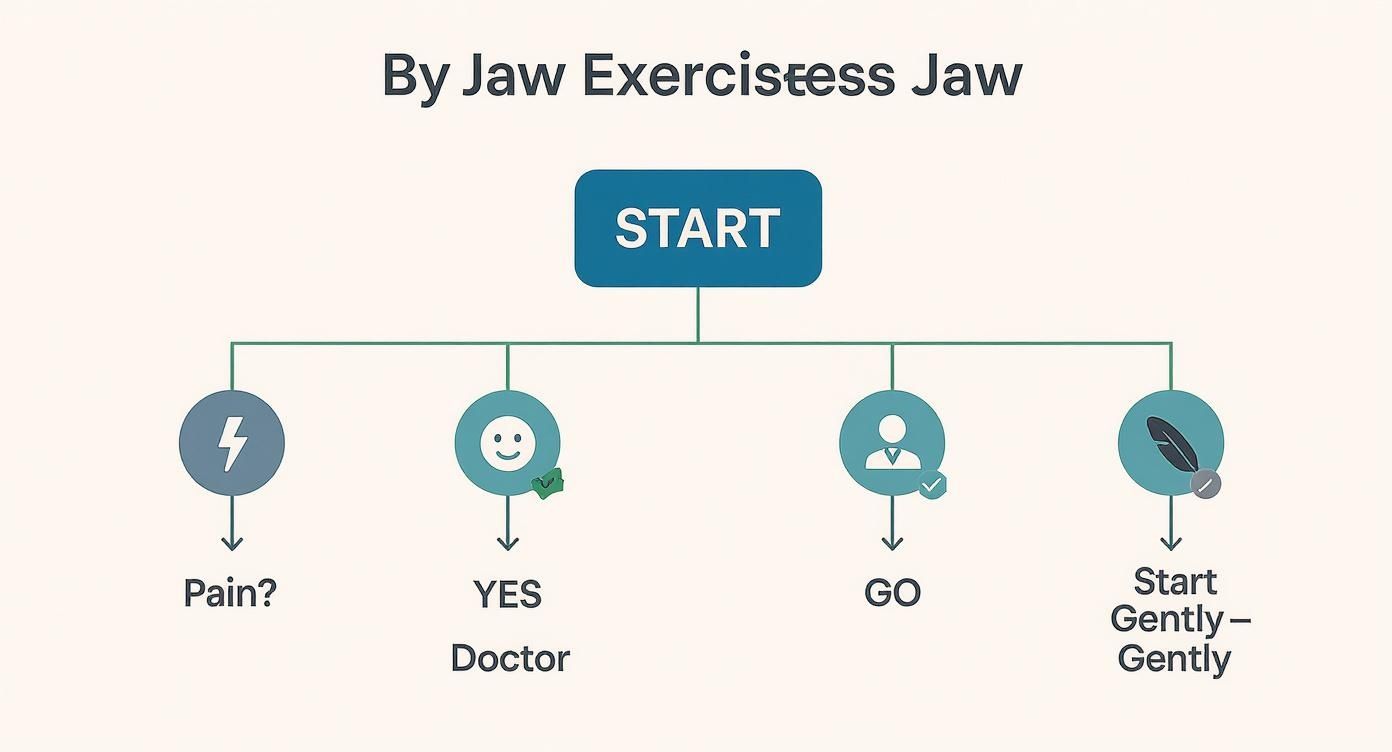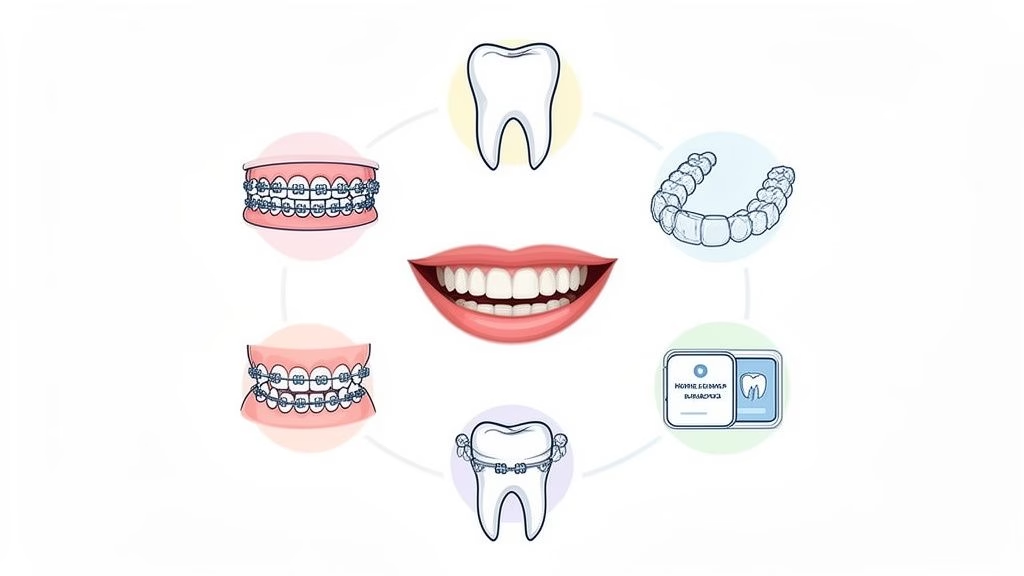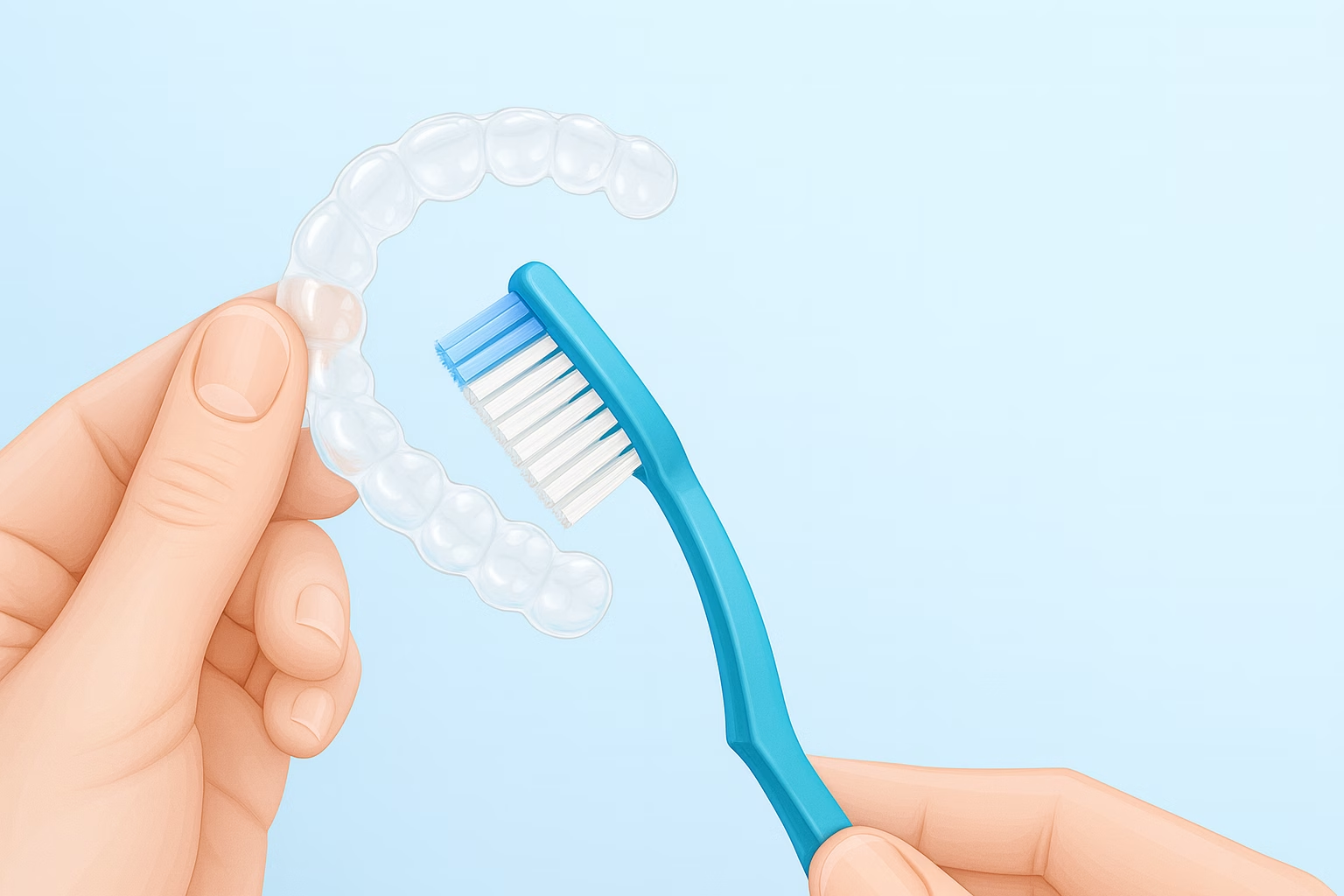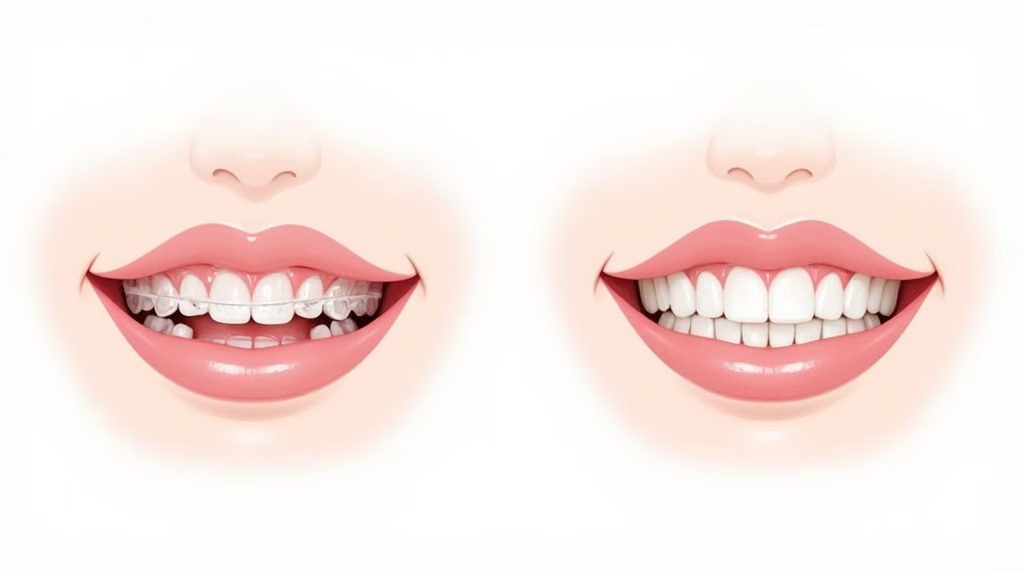How to Strengthen Jaw Muscles: Quick, Effective Exercises

You can build up your jaw muscles with some simple, targeted exercises. Things like resisted chin pushes or pressing your tongue to the roof of your mouth are great for building functional strength, which is a big win for your overall oral health and facial structure.
Why Strong Jaw Muscles Are Your Smile’s Foundation
When we talk about a healthy smile, our minds usually jump straight to straight, white teeth. But what about the unsung heroes holding everything together? The muscles that power your jaw are the real foundation of your oral health. They do a lot more than just chew—they support your entire facial structure, play a role in how you speak, and provide a stable base for your teeth.
The main powerhouses here are the masseter and temporalis muscles. This pair is responsible for clamping your jaw shut. The problem is, our modern diets are often packed with soft, processed foods, so these muscles rarely get the kind of workout they were designed for. This can lead to them becoming underdeveloped, which doesn’t just affect how your jawline looks, but how it functions, too.
More Than Just a Defined Jawline
Having a strong, balanced jaw brings a lot more to the table than just a sharper facial profile. It’s absolutely crucial for making sure any dental work you have done is successful and lasts. Think of it this way: your teeth are the house, but your jaw muscles and bone are the foundation. If that foundation is weak, the whole structure is at risk.
This is especially true when it comes to orthodontic treatments. It doesn’t matter if you’re looking at a specific aligner brand or a smarter, more affordable way to straighten teeth like Toothfairy; the long-term stability of your new smile really depends on the muscular support around it.
A strong muscular base helps to maintain the corrected bite and alignment you get from orthodontic work. It’s what makes sure your investment in a beautiful smile is truly built to last.
The Connection to Overall Health
The knock-on effects of jaw strength reach far beyond your mouth, tying directly into your general physical wellbeing. This link becomes even clearer as we get older.
Research from here in the UK has uncovered a significant link between poor oral health—including weak jaw muscles—and a faster decline in overall muscle strength and physical performance in older adults. It really drives home the point that jaw health isn’t some isolated issue; it’s a key piece of your body’s entire system. If you’re interested, you can dig into the full findings on jaw muscle impact on overall health.
Ultimately, just understanding this connection is the first step. When you realise your jaw muscles are a core part of your oral health, you can start taking a more holistic approach. It’s not just about aesthetics—it’s about building a durable, functional, and genuinely healthy smile from the ground up.
Kicking Off with the Basics: Foundational Jaw Exercises
Jumping into a jaw-strengthening routine doesn’t mean you need a bunch of fancy gadgets. Honestly, the best place to start is with simple, controlled movements that build a solid foundation. The real goal here is to create a sustainable habit, focusing on proper form to wake up those underused muscles without causing any strain.
Think of these foundational exercises as something you can do pretty much anywhere, anytime. When you’re just starting, consistency is way more important than intensity. It’s like learning any new skill—you have to nail the basics first to build good muscle memory and avoid picking up bad habits.
Using Your Body’s Own Resistance
Believe it or not, your own body provides all the resistance you need to get going. The following exercises use gentle pressure to engage the key muscles you use for chewing and that support your facial structure. It’s all about creating tension in a controlled way, which is a core concept in any strength training programme.
It can be helpful to understand the fundamental principles of building muscle mass, as the same logic applies here. Just like with any other muscle group, real progress comes from consistent, controlled effort over time.
Here are a few simple yet surprisingly effective exercises to start with:
- Resisted Chin Push: Pop your thumb under your chin. As you slowly open your mouth, gently push upwards with your thumb to create resistance. Hold it at the widest point for three to five seconds, then slowly close your mouth. This one directly targets the muscles that open your jaw.
- Tongue Roof Press: Press your entire tongue firmly against the roof of your mouth, right behind your front teeth. Keep that tension going for about five seconds. Try humming or making an “N” sound while you do it—this really helps engage the muscles under your chin and at the back of your jaw.
- Jaw Jut: Sit up straight and push your lower jaw forward until your bottom teeth are in front of your top teeth. Hold that position for five seconds, then relax. This move is great for strengthening the muscles that control the forward and backward movement of your jaw.
Try to do each of these for about 10 repetitions. Aim for one or two sets a day. The most important thing is to start slow and really concentrate on feeling the right muscles doing the work.
Your Guide to Safe and Effective Practice
Knowing the moves is only half the story. Doing them safely is what really matters for long-term success. The muscles in your jaw and face are delicate and closely linked to the sensitive temporomandibular joint (TMJ), so you absolutely have to take a gentle approach.
You need to listen to your body. A bit of mild muscle fatigue or a gentle stretch is what you’re aiming for. Sharp pain is not. If you feel any clicking, popping, or outright discomfort, stop what you’re doing and give it a rest. Pushing through pain is just asking for an injury and could lead to TMJ problems down the line.
The golden rule is simple: if it hurts, you’re doing too much, too soon. Healthy muscle engagement feels like work, not pain. If you feel discomfort, just dial back the intensity or do fewer reps until you find what feels right for you.
Finally, try to weave these exercises into your daily routine. You could do a set while waiting for the kettle to boil or during a quick break from your desk. Attaching a new habit to something you already do every day makes it much easier to stick with. It’s this gentle, regular practice that builds a strong, functional jaw for the long haul.
Stepping Up: Using Advanced Tools and Techniques Safely
So, you’ve mastered the foundational exercises and built a solid routine. Great work. Now, you might be wondering what’s next. To keep seeing improvements, you’ll need to introduce a core principle of strength training: progressive overload. This just means gradually making the exercises more challenging.
This is where advanced tools and specialised techniques enter the picture. But before you jump in, it’s vital to approach them with the right mindset—safely and smartly.
We’re not talking about those generic, often risky gadgets you see popping up in online ads. Instead, the focus should be on high-quality, dental-grade jaw exercisers that give you controlled, adjustable resistance. The goal isn’t just raw power; it’s about building balanced strength without placing dangerous stress on your temporomandibular joint (TMJ).
Choosing and Using Resistance Tools Wisely
The market for jaw exercisers can be a bit of a minefield. It’s crucial to find a device that lets you have precise control over the force you’re applying. This controlled resistance is the key difference between effective, safe training and reckless jaw work that can easily lead to injury.
Throughout this process, listening to your body is non-negotiable. This simple chart can help you decide when it’s safe to push ahead.

The message couldn’t be clearer: if you feel any pain, stop immediately. Don’t try to push through it. Consult a professional before you even think about continuing.
Some of the most exciting innovations in this area are coming out of the UK, with sophisticated devices designed for both strengthening and stretching. For example, newer tools allow you to apply a regulated, incremental force, often ranging from 0 to 60 Newtons. This precision lets you progressively increase the load safely, which is the gold standard for building strength. You can dive deeper into these emerging jaw rehabilitation techniques and their clinical uses.
To help you decide what’s right for you, here’s a quick comparison of the different approaches.
Comparing Jaw Strengthening Methods
| Method | Best For | Risk Level | Progression |
| Basic Bodyweight Exercises | Beginners or individuals with a history of jaw pain. | Low (when performed correctly). | Limited. Progression relies on increasing repetitions or hold times. |
| Resistance Tools | Intermediate to advanced users looking for significant strength gains. | Moderate to High. Requires careful selection and proper technique. | Excellent. Allows for precise, measurable increases in resistance. |
Ultimately, choosing between basic and advanced methods depends entirely on your starting point and what you want to achieve.
Don’t Forget Flexibility and Measurement
Intense strengthening work must always be balanced with stretching. Think about it—you wouldn’t go for a long run and then skip the stretches, would you? Your jaw muscles need that same level of care to stay flexible and prevent imbalances. Overworked, tight muscles are a recipe for trouble, potentially pulling your jaw out of alignment and causing TMJ problems.
Here are a couple of simple stretches to work into your routine:
- Gentle Jaw Opening: Slowly open your mouth as wide as feels comfortable (no pain!) and hold for 10 seconds.
- Side-to-Side Glide: Gently slide your lower jaw from one side to the other, holding each position for a few seconds.
If you’re serious about tracking your gains, a muscle testing dynamometer can be an incredibly useful tool. These devices give you hard data on your muscle strength, taking the guesswork out of your progress and helping you fine-tune your routine.
Remember, advanced training is all about building functional strength that supports your long-term oral health. It’s not a race to the finish line. Slow, safe progression is what will enhance your jaw’s function without risking its health—something that’s especially important if you’re undergoing orthodontic or cosmetic dental work with services like Toothfairy.
How a Strong Jaw Can Help Keep Your Teeth Straight
Getting that perfectly straight smile is a fantastic goal, but it’s really only half the story. The muscles that support your jaw and teeth are just as crucial for making sure those results stick around for the long haul. Think of your jaw muscles as the foundation of a house; your teeth are the structure built on top of it.
When your facial muscles are properly developed, they create a stable, balanced environment that helps maintain the results of any teeth-straightening treatment. This muscular framework works hand-in-hand with your orthodontics, creating a system where every part supports the other. Without it, teeth have a tendency to shift back to their old positions after treatment—something dentists call orthodontic relapse.
The Connection Between Your Muscles and a Stable Smile
When your jaw muscles are strong and well-balanced, they apply even, gentle pressure across your teeth and jawbone. This equilibrium is incredibly important, both during and after any orthodontic work. Treatments like clear aligners, whether from a specific aligner brand or a smarter, more affordable provider like Toothfairy, work by carefully guiding your teeth into their correct spots.
But the real challenge begins once the aligners are off. Strong jaw muscles are what help “lock in” that new alignment. They provide the support needed to resist the everyday forces in your mouth—from chewing your lunch to chatting with friends—that might otherwise cause your teeth to drift.
A strong muscular foundation essentially acts as a natural retainer. It helps secure your new bite and alignment, protecting your investment in a beautiful smile for years to come.
This more holistic view is a big part of modern dental thinking. We’ve come to realise that teeth don’t exist in a vacuum; they’re part of an intricate system of muscles, bones, and joints that all need to work together.
Preventing Bite Problems and Uneven Wear
A lack of jaw strength, or even an imbalance where one side is stronger than the other, can lead to bite problems like an overbite or a crossbite. When this happens, certain teeth end up taking more of the strain when you chew. Over time, this can cause a cascade of issues:
- Uneven tooth wear: You might notice some teeth wearing down much faster than others.
- Chipping or fractures: Teeth under constant, excessive pressure are far more likely to get damaged.
- TMJ strain: Muscle imbalances often put extra stress on the jaw joint itself, which can lead to pain and discomfort.
Learning how to strengthen jaw muscles properly helps distribute all those chewing forces correctly. By building a balanced muscular structure, you’re not just supporting your orthodontic results—you’re also promoting the long-term health of your teeth and jaw joints. This synergy is the key to a smile that isn’t just beautiful, but genuinely healthy and resilient.
Common Mistakes and How to Sidestep Them
When you’re first getting into jaw strengthening, it’s easy to make a few classic mistakes. The enthusiasm is great, but remember, we’re dealing with a delicate and complex area. Pushing for results too quickly can backfire, leading to more problems than you started with.
The temporomandibular joint (TMJ) isn’t like your bicep; it’s an intricate system of muscles and joints that needs a careful, considered approach. Let’s walk through the most common pitfalls I see and, more importantly, how you can avoid them.
Going Too Hard, Too Soon
This is, by far, the biggest mistake people make. Your jaw muscles, just like any other muscle group, need time to recover and adapt. If you start hammering them with high-intensity exercises every day, you’re not building strength—you’re just inviting inflammation and potential injury.
Think progress, not perfection. A bit of healthy muscle fatigue tells you you’ve had a solid workout. Sharp, shooting, or lingering pain is your body’s way of screaming “Stop!”
Another major issue is poor form. Biting down with jerky, uncontrolled movements doesn’t do much for functional strength. It just puts uneven, potentially damaging stress on your jaw joints. Instead, focus on slow, deliberate motions. You should really feel the target muscles engaging with each and every repetition.
How to Spot the Warning Signs
Your body is pretty good at sending signals when something isn’t right. The trick is learning to listen to them. When it comes to your jaw, there are a few red flags that mean you need to pull back immediately.
Keep an eye out for any of these signs:
- Clicking or Popping: While a little click might be normal for some, any new, loud, or painful clicking is a definite warning.
- Lingering Pain: A dull ache that sticks around long after you’ve finished exercising, or any sharp pain during an exercise, is a clear signal to stop.
- Headaches or Earaches: If you suddenly start getting headaches around your temples or unexplained earaches, it could be connected to TMJ strain.
- Limited Movement: Does your jaw feel stiff? Is it difficult to open or close your mouth fully? You’re likely overdoing it.
Here’s the most important piece of advice I can give you: If you have a history of jaw pain, TMD, or have had any significant dental work done, please talk to a professional before starting. A dentist or a physiotherapist can offer guidance that’s right for your specific situation.
In the UK, using resistance training for the masticatory (chewing) muscles is becoming a more recognised way to improve jaw function, especially for those dealing with TMD. New research is exploring how targeted exercises affect jaw pain and mobility, showing real promise for boosting both strength and neuromuscular performance. You can read more about these developing masticatory muscle training plans.
Your Questions on Jaw Strengthening Answered
As you get started with jaw exercises, a few questions are bound to come up. It’s completely normal to wonder what’s realistic and how to go about strengthening your jaw muscles safely. Let’s tackle some of the most common queries I hear.
How Long Until I See Results from Jaw Exercises?
This is the big one, isn’t it? The key here is consistency over intensity. You’ll likely feel a difference fairly quickly, maybe within a few weeks. Think less muscle tension and a better sense of engagement when you chew.
But when it comes to visible changes – like a more defined jawline – you need to be patient. We’re talking several months of dedicated work. Your personal results will really depend on your starting point, your genetics, and, most importantly, how consistently you’re doing the exercises with the right form.
Can These Exercises Get Rid of a Double Chin?
Let’s be clear: these exercises strengthen the muscles underneath the fat, but they don’t burn the fat itself. So, while they can definitely help create a more toned, sculpted foundation for your jawline, they aren’t a magic bullet for a double chin.
For the best results, think of these exercises as one piece of the puzzle. Combining targeted jaw strengthening with a balanced diet and overall fitness is the most effective way to reduce the appearance of a double chin.
Is It Safe to Do These Exercises with Fillings or Crowns?
This is a really important question. The short answer is: always check with your dentist first. Gentle exercises that only use your body’s own resistance are usually fine for most people.
Where you need to be careful is with high-resistance gadgets. They can put a lot of pressure on your teeth and any existing dental work. A quick chat with your dentist will give you personalised advice and peace of mind, so you know you’re strengthening your jaw without putting your smile at risk.
If you’re thinking about cosmetic dental work or getting your teeth straightened, building a strong and stable jaw first is a smart move. A healthy muscular foundation helps support great, long-lasting results.
Are There Foods That Naturally Strengthen Your Jaw?
Absolutely! Your diet can be a fantastic, low-key workout for your jaw. Simply swapping some softer, processed foods for chewier alternatives gives your chewing muscles a gentle but consistent challenge.
A few easy additions include:
- Crisp fruits and vegetables, like whole apples and raw carrots.
- Nuts and seeds, especially almonds.
- Lean, chewy meats.
Think of these foods as a natural supplement to the more focused exercises we’ve talked about. They all contribute to your overall jaw health.
A strong, functional jaw really is the bedrock of a beautiful, lasting smile. If you’re looking into straightening your teeth or just need some expert dental advice, Toothfairy offers a smarter, more affordable way to get professional care, right from your phone.
Find out how you can get started with Toothfairy today and build the healthy smile you deserve.
Last updated on October 27, 2025

Toothfairy Care Team
Toothfairy, is the world's smartest dental app, that connects patients to a dentist for a range of issues, from emergencies, cosmetics, prescriptions to virtual exams.
Toothfairy Care Team
Toothfairy, is the world's smartest dental app, that connects patients to a dentist for a range of issues, from emergencies, cosmetics, prescriptions to virtual exams.





